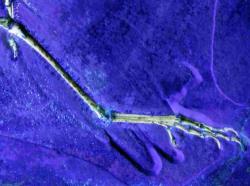The world is a mask that hides the real world.
Thatâs what everybody suspects, though the world we see wonât let us dwell on it long.
The world has ways - more masks - of getting our attention.
The suspicion sneaks in now and again, between the cracks of everyday existenceâ¦the bird song dips, rises, dips, trails off into blue sky silence before the note that would reveal the shape of a melody that, somehow, would tie everything together, on the verge of unmasking the hidden armature that frames this sky, this tree, this bird, this quivering green leaf, jewels in a crown.â¦
As the song dies, the secret withdraws.
The tree is a mask.
The sky is a mask.
The quivering green leaf is a mask.
The song is a mask.
The singing bird is a mask.
Thursday, December 01, 2005
line blurs between early dinosaurs & birds
19:00 01 December 2005
NewScientist.com news service
by Jeff Hecht
The oldest known bird was closer to a dinosaur than previously thought – a discovery that confuses the evolutionary tree as we currently understand it.
An exceptionally well preserved new fossil reveals a foot and skull that more closely resemble those of a group of two-legged predatory dinosaurs called the known as dromeosaurs, than modern birds.
With jagged teeth and a dinosaur-like skeleton, the archaeopteryx is unlike any modern species of bird. But flight feathers on its long front limbs have led palaeontologists to identify the creature as the oldest known species of bird.
Nine previously known specimens of archaeopteryx have led palaeontologists to conclude that birds probably evolved from small meat-eating dinosaurs, and are closely related to the dromeosaurs, a group that includes the velociraptor. Yet precisely how archaeopteryx is related to the raptors has remained unclear – key pieces of these previous specimens are missing.
But the newly revealed fossil appears to fill in many of the gaps. The specimen comes from the private collection of a worker at the Solnhofen limestone quarries in Germany, where the first archaeopteryx fossil was discovered. It has remained unknown to science until its owner's death, when the new owner made it available to scientists at the Wyoming Dinosaur Center in the US.

With jagged teeth and raptor-like features, the feathered archaeopteryx is unlike any modern species of bird (Image: G Mayr/Senckenberg)
Computer model
A complete foot reveals that archaeopteryx had an extensible claw on its second toe, which is a hallmark of raptors, but is absent in all known birds. Its first toe, or "hallux", is also at the side of the foot and not reversed as it is in perching birds, which use it to grasp branches.
The skull is also well preserved and shows that the animal had a skull bone known as the "palatine", which is shaped in the same way as in many two-legged dinosaurs.
The new traits were added to a computer model, enabling palaeontologists to analyse the relationship between extinct species. "It's now very difficult to distinguish between [early] birds and [early] dromeosaurs," says Gerald Mayr of the Senckenberg Research Institute in Frankfurt, Germany, who studied the specimen.
Question of class
Mayr told New Scientist that there are no unique traits shared by archaeopteryx and other early bird-like fossils that are not present in dinosaurs. This would either mean that archaeopteryx cannot be classed within the same evolutionary group as birds or that this group needs to be redefined.

Ultraviolet light enhances details of a complete foot, showing that archaeopteryx had an extensible claw on its second toe – a hallmark of raptors – which is absent in all known birds (Image: G Mayr/Senckenberg)
But Peter Makovicky of the Field Museum of Natural History in Chicago, US, says those results are shaky because Mayr's group considered only three bird-like creatures; archaeopteryx, confuciusornis and a primitive bird called Rahonavis, that lived much later.
In October 2005, Makovicky carried out a separate study that links Rahonavis directly to the dromeosaurs and suggests this species may have evolved flight separately from archaeopteryx and other birds. Makovicky told New Scientist he found no change in the shape of his evolutionary tree when he added the new traits found for archaeopteryx.
Journal reference: Science (Vol 310, p 1483)
Related Articles
Raptor inflicted death by a thousand bites
http://www.newscientist.com/article.ns?id=mg18825224.600
22 October 2005
Can 'feather foot' knock oldest bird off its perch?
http://www.newscientist.com/article.ns?id=mg18524874.700
19 February 2005
Flying dinosaur needed a bird's brain
http://www.newscientist.com/article.ns?id=dn6244
04 August 2004
Weblinks
Science
http://www.sciencemag.org/
Field Museum of Natural History
http://www.fieldmuseum.org/
Senckenberg Research Institute
http://www.senckenberg.de/




